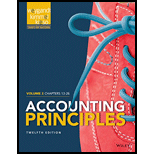
Concept explainers
(a)
Periodic Inventory System: It is a system in which the inventory is updated in the accounting records on a periodic basis such as at the end of each month, quarter or year. In other words, it is an accounting method which is used to determine the amount of inventory at the end of each accounting period.
Income Statement: The income statement is that financial statement which shows the net income (or loss) of the Company. In the income statement, to calculate the net income, all expenses incurred by the Company are deducted from the total revenue of the Company.
Gross Profit: It is that profit which is computed by deducting Cost of goods sold from the net sales (Sales after deducting Sales Return and allowances, Sales Discounts).
To prepare: The correct income statement for 2 years.
(b)
To identify: The cumulative effect of the inventory error on total gross profit for the 2 years.
(c)
To prepare: A letter to explain the nature of inventory error and its effect on the financial statements of the company.
Trending nowThis is a popular solution!

Chapter 6 Solutions
Accounting Principles, Volume 2: Chapters 13 - 26
- Laxmi Corporation reported financial information for the year 2016 as follows: The company had a net income of €180,000 for the year. In addition, there was an unrealized gain of €15,000 related to the revaluation of buildings. However, the company also reported an unrealized loss of €40,000 on non-trading securities. Based on this information, determine Laxmi Corporation’s total comprehensive income for 2016. Need helparrow_forwardSHOW ALL WORKINGS - complete the following ttable attached - the main items listed should be , Balance , service cost , interest expense , interest revenue , contributions , benefits , asset loss/gain , liability loss / gain , Journal entry , accumulated OCI , then ending balance . The info for the question is - FlagStaff Ltd has a defined benefit pension plan for its employees. The company is considering introducing a defined benefit contribution plan, which will be available to all incoming staff. Although the defined benefit plan is now closed to new staff, the fund is active for all employees who have tenure with the company. In 2020, the following actuarial report was received for the defined benefit plan: 2020/$ Present value of the defined benefit obligation 31 December 2019 18 000 000 Past Service Cost 4 000 000 Net interest ? Current service cost 600 000 Benefits paid 2 000 000 Actuarial gain/loss on DBO ? Present value of the defined benefit obligation 31…arrow_forward4 POINTarrow_forward
- Cost of equipment?????arrow_forwardLaxmi Corporation reported financial information for the year 2016 as follows: The company had a net income of €180,000 for the year. In addition, there was an unrealized gain of €15,000 related to the revaluation of buildings. However, the company also reported an unrealized loss of €40,000 on non-trading securities. Based on this information, determine Laxmi Corporation’s total comprehensive income for 2016. Need yarrow_forwardGeneral Account ting 5.1arrow_forward
- Dunbar Corporation's account balances at December 31 for Accounts Receivable and the related Allowance for Doubtful Accounts are $950,000 and $15,000, respectively. From an analysis of accounts receivable, it is estimated that $38,000 of the December 31 receivables will be uncollectible. After adjustment for the above facts, what would be the net realizable value of accounts receivable?arrow_forwardAnswer this Questionarrow_forwardUnit completed and transferred out wasarrow_forward

 AccountingAccountingISBN:9781337272094Author:WARREN, Carl S., Reeve, James M., Duchac, Jonathan E.Publisher:Cengage Learning,
AccountingAccountingISBN:9781337272094Author:WARREN, Carl S., Reeve, James M., Duchac, Jonathan E.Publisher:Cengage Learning, Accounting Information SystemsAccountingISBN:9781337619202Author:Hall, James A.Publisher:Cengage Learning,
Accounting Information SystemsAccountingISBN:9781337619202Author:Hall, James A.Publisher:Cengage Learning, Horngren's Cost Accounting: A Managerial Emphasis...AccountingISBN:9780134475585Author:Srikant M. Datar, Madhav V. RajanPublisher:PEARSON
Horngren's Cost Accounting: A Managerial Emphasis...AccountingISBN:9780134475585Author:Srikant M. Datar, Madhav V. RajanPublisher:PEARSON Intermediate AccountingAccountingISBN:9781259722660Author:J. David Spiceland, Mark W. Nelson, Wayne M ThomasPublisher:McGraw-Hill Education
Intermediate AccountingAccountingISBN:9781259722660Author:J. David Spiceland, Mark W. Nelson, Wayne M ThomasPublisher:McGraw-Hill Education Financial and Managerial AccountingAccountingISBN:9781259726705Author:John J Wild, Ken W. Shaw, Barbara Chiappetta Fundamental Accounting PrinciplesPublisher:McGraw-Hill Education
Financial and Managerial AccountingAccountingISBN:9781259726705Author:John J Wild, Ken W. Shaw, Barbara Chiappetta Fundamental Accounting PrinciplesPublisher:McGraw-Hill Education





